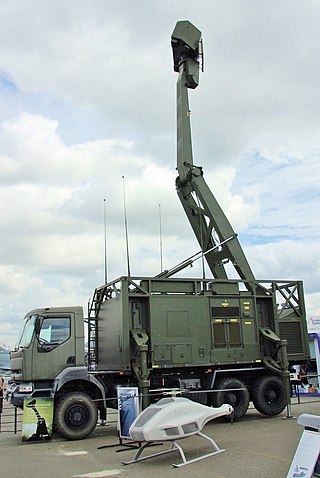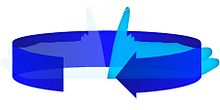
Radar is a radiolocation system that uses radio waves to determine the distance (ranging), angle (azimuth), and radial velocity of objects relative to the site. It is used to detect and track aircraft, ships, spacecraft, guided missiles, motor vehicles, map weather formations, and terrain. A radar system consists of a transmitter producing electromagnetic waves in the radio or microwaves domain, a transmitting antenna, a receiving antenna and a receiver and processor to determine properties of the objects. Radio waves from the transmitter reflect off the objects and return to the receiver, giving information about the objects' locations and speeds.

In antenna theory, a phased array usually means an electronically scanned array, a computer-controlled array of antennas which creates a beam of radio waves that can be electronically steered to point in different directions without moving the antennas. The general theory of an electromagnetic phased array also finds applications in ultrasonic and medical imaging application and in optics optical phased array.

Imaging radar is an application of radar which is used to create two-dimensional images, typically of landscapes. Imaging radar provides its light to illuminate an area on the ground and take a picture at radio wavelengths. It uses an antenna and digital computer storage to record its images. In a radar image, one can see only the energy that was reflected back towards the radar antenna. The radar moves along a flight path and the area illuminated by the radar, or footprint, is moved along the surface in a swath, building the image as it does so.

Rajendra is a passive electronically scanned array radar developed by the Defence Research and Development Organisation (DRDO). It is a multifunction radar, capable of surveillance, tracking and engaging low radar cross section targets. It is a ground surveillance radar and is a great source of surveillance operating at frequency around 20 GHz. It is mainly used to track enemy's installations.

The AN/MPQ-64 Sentinel is an X-band electronically steered pulse-Doppler 3D radar system used to alert and cue Short Range Air Defense (SHORAD) weapons to the locations of hostile targets approaching their front line forces. It is currently produced by Raytheon Missiles & Defense.

The EL/M-2075 Phalcon is an airborne early warning and control (AEW&C) active electronically scanned array radar system developed by Israel Aerospace Industries (IAI) and Elta Electronics Industries of Israel. Its primary objective is to provide intelligence to maintain air superiority and conduct surveillance. It was surpassed by newer versions—the EL/W-2085 and the EL/W-2090.

An airport surveillance radar (ASR) is a radar system used at airports to detect and display the presence and position of aircraft in the terminal area, the airspace around airports. It is the main air traffic control system for the airspace around airports. At large airports it typically controls traffic within a radius of 60 miles (96 km) of the airport below an elevation of 25,000 feet. The sophisticated systems at large airports consist of two different radar systems, the primary and secondary surveillance radar. The primary radar typically consists of a large rotating parabolic antenna dish that sweeps a vertical fan-shaped beam of microwaves around the airspace surrounding the airport. It detects the position and range of aircraft by microwaves reflected back to the antenna from the aircraft's surface. The secondary surveillance radar consists of a second rotating antenna, often mounted on the primary antenna, which interrogates the transponders of aircraft, which transmits a radio signal back containing the aircraft's identification, barometric altitude, and an emergency status code, which is displayed on the radar screen next to the return from the primary radar.

A height finder is a ground-based aircraft altitude measuring device. Early height finders were optical range finder devices combined with simple mechanical computers, while later systems migrated to radar devices. The unique vertical oscillating motion of height finder radars led to them also being known as nodding radar. Devices combining both optics and radar were deployed by the U.S. Military.
The JY-8 is a mobile 3D air surveillance, target acquisition and interception control radar system operating in the C-band. It can be employed as the main radar sensor for an automated tactical defence system, or can be used as an independent radar. The system uses advanced signal/data processor techniques and is fully solid state with the exception of the magnetrons and thyratrons of the transmitters. The general designer of JY-9 is the head of 38th Research Institute, academician of Chinese Academy of Sciences Mr. Wu Manqing, who is also the general designer of JY-9 and the general designer of the radar systems for KJ-2000 and KJ-200.

The AN/SPS-48 is a US naval electronically scanned array, air search three-dimensional radar system manufactured by ITT Exelis and deployed in the 1960s as the primary air search sensor for anti-aircraft warships. The deployment of the AN/SPY-1 and the end of the Cold War led to the decommissioning of many such ships, and many of these vessel's AN/SPS-48 sets were reused on aircraft carriers and amphibious ships where it is used to direct targets for air defense systems such as the Sea Sparrow and RIM-116 SAM missiles. Existing sets are being modernized under the ROAR program to AN/SPS-48G standard for better reliability and usability.

The Saab Giraffe Radar is a family of land and naval two- or three-dimensional G/H-band passive electronically scanned array radar-based surveillance and air defense command and control systems. It is tailored for operations with medium- and Short Range Air Defense (SHORAD) missile or gun systems, or for use as gap-fillers in a larger air defense system.

Multiservice tactical brevity codes are codes used by various military forces. The codes' procedure words, a type of voice procedure, are designed to convey complex information with a few words.
Electronics and Radar Development Establishment (LRDE) is a laboratory of the Defence Research & Development Organisation (DRDO), India. Located in C.V. Raman Nagar, Bengaluru, Karnataka, its primary function is research and development of radars and related technologies. It was founded by S. P. Chakravarti, the father of Electronics and Telecommunication engineering in India, who also founded DLRL and DRDL.

The central acquisition radar (3D-CAR) is a 3D radar developed by DRDO for use with Akash SAM capable of tracking 150 targets.
Track-while-scan (TWS) is a mode of radar operation in which the radar allocates part of its power to tracking a target or targets while part of its power is allocated to scanning. It is similar to but functions differently in comparison to its counterparts range-while-search (RWS), long range search (LRS), air combat mode (ACM), velocity search with ranging (VSR) and combined radar mode (CRM). In track-while-scan mode the radar has the ability to acquire and lock/track multiple targets while simultaneously providing a view of the surrounding airspace, which in turn aids the pilot and or operator in maintaining better situational awareness.

Selex RAN-40L is a naval 3D L band search radar developed by Leonardo. The radar is used for long range maritime air surveillance and early warning. The radar uses a fully solid state active phased array antenna and capable of tracking and detecting air targets like aircraft or drones up to 400 km away. RAN-40L is based on existing land based 3D RAT-31DL radar which is a system widely used by NATO Countries for long air surveillance.

The AMES Type 82, also widely known by its rainbow codename Orange Yeoman, was an S-band 3D radar built by the Marconi Company and used by the Royal Air Force (RAF), initially for tactical control and later for air traffic control (ATC).
Martello is a family of phased array radar systems developed by Marconi Electronic Systems in the 1970s and introduced operationally in the early 1980s. They provided long-range early warning capabilities but also had the accuracy needed for interception plotting and "putting on" of other weapons systems like surface-to-air missiles. The name comes from the Martello towers that provided defence in earlier years.
The AR-320 is a 3D early warning radar developed by the UK's Plessey in partnership with US-based ITT-Gilfillan. The system combined the receiver electronics, computer systems and displays of the earlier Plessey AR-3D with a Gilfillan-developed transmitter and planar array antenna from their S320 series. The main advantage over the AR-3D was the ability to shift frequencies to provide a level of frequency agility and thus improve its resistance to jamming.
















